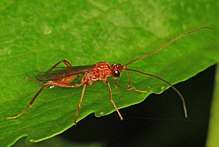Meteorinae
Meteorinae is a subfamily of braconid parasitoid wasps. Several species have been used in biological control programs. The name for this group comes from the pupal stage, which, in species attacking Lepidopteran hosts, hangs suspended from a long thread of silk.[1]
| Meteorinae | |
|---|---|
 | |
| Meteorus sp. | |
| Scientific classification | |
| Kingdom: | |
| Phylum: | |
| Class: | |
| Order: | |
| Family: | |
| Subfamily: | Meteorinae |
Description and distribution
Meteorines are characterized by an open 1st subdiscal cell and a four-sided 2nd subdiscal cell of the forwings. They have a distinctive petiolate waist.[1]
They are found worldwide, in habitats where their hosts can be found.[1]
Biology
.jpg)
Meteorines are koinobiont endoparasitiods of Coleoptera or Lepidoptera larvae. Some species are known to have broad host ranges, meaning they can attack many species of hosts. Most are solitary, laying a single egg per host, but some are gregarious and many larvae develop within a single host. Many species are nocturnal as adults.[1]
Genera
Two genera are found in North America, Meteorus and Zele. Recent evidence suggests that Meteorus may be paraphyletic with respect to Zele, but synonymyzing the two genera could potentially cause great confusion in the scientific literature.[2]
Use in biological control
Many hosts of Meteorines are considered pests, especially of forests, making them good candidates for biocontol projects. Meteorus pulchricornus has been imported to North America on multiple occasions to attempt to control the gypsy moth.[3] M. vesicolor was introduced to the United States in the early 1900s for the control of the brown-tail moth.[4] M. trachynotus was investigated for control of spruce budworm[5] as was M. hypophloei for controlling bark beetles.[6] Other species have been used in control of cutworms, avocado looper, and swallowtail pests on citrus crops.[1]
References
- Wharton, Robert A.; Marsh, Paul M.; Sharkey, Michael J. (1997). Manual of the New World Genera of the Family Braconidae (Hymenoptera) (PDF). Washington DC: The International Society of Hymenopterists. p. 69.
- Stigenberg, Julia; Boring, Charles Andrew; Ronquist, Fredrik (2015-07-01). "Phylogeny of the parasitic wasp subfamily Euphorinae (Braconidae) and evolution of its host preferences". Systematic Entomology. 40 (3): 570–591. doi:10.1111/syen.12122. ISSN 1365-3113.
- Coulson, J., Fuester, R. W., Schaefer, P. W., Ertle, L. R., Kelleher, J. S., and Rhoades, L. D. 1986. Exploration for and importation of natural enemies of the gypsy moth, Lymantria dispar (L.) (Lepidoptera: Lymantriidae), in North America: an update. Proceedings of the Entomological Society of Washington 88: 461-475.
- Muesebeck, Carl Frederick William (1920). A Revision of the North American Species of Ichneumon-flies Belonging to the Genus Apanteles. U.S. Government Printing Office.
- McGugan, Blair M. (1955). "Certain Host-Parasite Relationships Involving the Spruce Budworm1". The Canadian Entomologist. 87 (4): 178–187. doi:10.4039/Ent87178-4. ISSN 1918-3240.
- DeLeon, D. 1933. Notes on the biology of Meteorus hypophloei Cushman. Bulletin of the Brooklyn Entomological Society 28: 32-37.